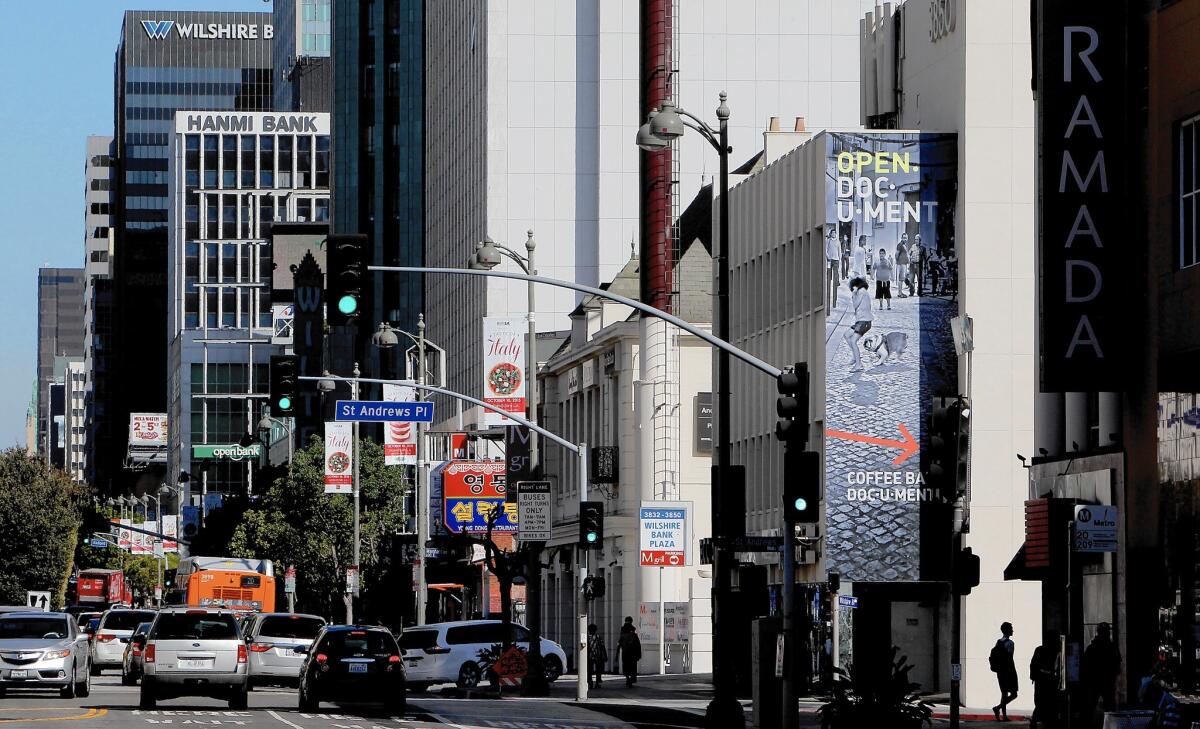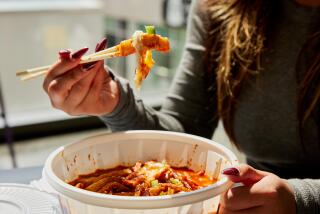How a plan to create a much-needed park in Koreatown withered

Koreatown is a densely packed neighborhood short on green space. A 346-unit luxury apartment building is going up on the spot where a park was proposed.
The people of Koreatown were on the brink of getting something urban planners and psychologists said Los Angeles’ most densely packed neighborhood desperately needed: A public outdoor space for respite in a booming urban corridor increasingly smothered in concrete and glass.
Now, five years later, a 346-unit luxury apartment building dubbed the Pearl on Wilshire is taking root where Koreatown Central Park was slated to go. It will have a dog wash, yoga room, putting green and spa, but not so much as a park bench for public use.
And as heavy equipment roars and beeps at the once-vacant lot at Wilshire and Hobart boulevards, people familiar with the abandoned project are left to wonder: Who’s to blame for letting a park die in this neighborhood where residents have about one-hundredth of the park space as the average Angeleno citywide?
The state had, after all, already awarded $5 million to the project to transform part of the lot into an open public space, with a community garden, walking loop and splash pad for kids.
In 2011, the Community Redevelopment Agency agreed to use the state money and add additional dollars to buy half the lot for $9.9 million, in partnership with Don Hankey, a local investor who would develop the other half of the site into apartments with retail space.
“Christmas comes early for Koreatown residents,” the real estate website Curbed LA wrote at the time.
A few weeks later, however, Gov. Jerry Brown dissolved community redevelopment agencies statewide, leaving it to cities to keep such projects on course.
Elsewhere in the city and state, civic leaders picked up where the CRA left off and moved forward on proposed parks.
Koreatown’s park quietly fizzled.
Steve Rasmussen Cancian, a landscape architect who drew up the designs for the Koreatown park, notes that another CRA-funded park he worked on in a low-income neighborhood in Santa Rosa broke ground last year.
“The local leadership in Santa Rosa figured out a way to get from here to there,” Cancian says.
In Koreatown, he says he was “disappointed in the abdication of political leadership.”
Where people do not have much political power, they don’t have a strong voice to demand parks
— Anastasia Loukaitou-Sideris, professor of urban planning at UCLA
The idea of putting a park on that block goes back at least seven years.
When a South Korean developer’s plan for a 40-story luxury high-rise fell through in 2008, community activists and area residents rallied around the dirt lot as a potential site for a much-needed park in the densely-populated neighborhood.
They lined the surrounding sidewalks with grass turf and turned it into a public recreation space for a day with picnic tables, a sandbox and mini basketball court. They hurled seeds over the chain-link fence surrounding the lot to get sunflowers and beans sprouting on the abandoned site.
The need was palpable.
At a private lawn up the street on Wilshire, in front of an office building, security guards spent their shifts chasing people off the well-manicured grass.
At a McDonald’s around the corner, elderly Korean men lingered at the outdoor tables for so long it became known as the McDonald’s senior center.
Park planners say the minimum adequate park space for an area is three acres per every 1,000 residents. Koreatown has less than 0.07 acres per 1,000 — an area roughly three-fourths the size of a basketball court. That’s about three square feet per person — a space too small to fit a coffin.
When the plan for the corner of Wilshire and Hobart gained traction, Hankey, the investor, jumped at the opportunity to form a private-public partnership.
“If you can get a park with a lot of people around, it’s a win-win for the city and business,” he says.
He envisioned a bustling restaurant abutting the park. The city approved the plan. Then the redevelopment agency’s involvement ended.
In other Los Angeles neighborhoods, leaders found ways to keep park projects going.
In Chinatown, Councilman Gil Cedillo and Supervisor Gloria Molina tapped more than $3 million in city and county money to supplement a $5-million state grant and keep the Ord & Yale Street Park alive.
Downtown, councilman Jose Huizar tapped $1.5 million in funds paid by developers to keep the Arts District Park on track. Crews broke ground in 2014.
Koreatown Central Park, meanwhile, landed in Los Angeles’ sprawling boneyard of abandoned urban planning dreams.
And no one involved has stepped up to take responsibility.
After Brown dissolved the CRA, Hankey, the investor who wanted to build apartments, was contractually obligated to buy the entire lot.
It was then up to the city to come up with the money to supplement the $5 million that the state had earmarked and buy back from Hankey the portion of the lot where the park was to be built.
But the city wasn’t able to put together the real estate deal that would have secured the site within a one-year grace period, says Sedrick V. Mitchell at the state Department of Parks and Recreation.
Darryl Ford, principal project coordinator for the city’s Department of Recreation and Parks, says that the city was unwilling to pay the price the CRA had previously agreed to pay for the lot because the amount was higher than its appraised value.
Council President Herb Wesson’s spokeswoman, Vanessa Rodriguez, blames the city’s failure to get the park built on bad timing and the recession. Wesson, whose district includes most of Koreatown and who would have been the most likely civic leader to find the money needed to save the park, did the best he could given the circumstances, she says.
About all anyone can agree on is that the park that almost happened is still urgently needed.
Danny Park, a community activist and former executive director of the Koreatown Immigrant Workers Alliance who campaigned for the central park, says he never thought Wesson was truly supportive of it.
Although Park has since moved out of Los Angeles, he still laments the missed opportunity.
“We were really close,” he says. “Every single person needs green space. It’s much more crucial here because our population lives in apartments, and don’t have yards or lawns.”
What happened with Koreatown Central Park is a familiar story, says Anastasia Loukaitou-Sideris, a professor of urban planning at UCLA who has written extensively about the politics of public space in Los Angeles.
The failure, she says, reflects the disconnect between the businessmen and interest groups who hold sway and the largely modest-income residents who actually live in the area.
“Where people do not have much political power, they don’t have a strong voice to demand parks,” she says.
Rodriguez, Wesson’s spokeswoman, says his office is looking into other places to build parks and is trying to come up with ways to “get creative with existing resources.”
The councilman has proposed turning part of the local library branch’s 55-space parking lot, a block over from the former central park site, into a pocket park. In December, the council passed a motion instructing engineers to study whether it would be feasible to build an underground garage with a park on top.
One of those waiting is Samantha Reyes, a high school freshman who lives a mile from Shatto Recreation Center, the closest park to her Koreatown home.
She walks there after school most afternoons. On weekends, it gets so packed that there’s a line for the swings and perpetual jostling for use of the basketball court.
On days when she can’t make it to the park, she resorts to playing soccer in the street with the neighborhood kids. Most cars will stop. A few blare a warning to get out of the way and keep driving.
“Every once in a while, you want to get out of your house,” Reyes says.
“It gets boring at home,” chimes in her friend Diana Oliva, who also lives in Koreatown.
“A lot of these kids, they play on the streets, play in vacant lots,” says Caroline Sim, who was in charge of the park proposal at the Community Redevelopment Agency until 2011 and has since become a Koreatown activist.
In the meantime, real estate prices in Koreatown have soared. The lot the city decided not to buy would sell today for nearly double what Hankey paid for it, the developer says.
At the March ceremony unveiling the Pearl on Wilshire, Wesson praised the development.
On a recent morning, whirs and beeps were heard from the construction site as a skip loader moved mounds of dirt and workers laid concrete blocks. A graffiti-covered sign advertised: “Your next home in the heart of Koreatown.”
When the development is completed in early 2018, it will feature a courtyard with flower beds, trees and water features.
All that will be tucked away on the third floor, open only to the building’s residents.
Twitter: @vicjkim
ALSO
Uber and Lyft have devastated L.A.’s taxi industry, city records show
Board recommends parole for Manson follower; victim’s daughter outraged
In a win for unions, appeals court reverses ruling that threw out teacher tenure in California
More to Read
Start your day right
Sign up for Essential California for news, features and recommendations from the L.A. Times and beyond in your inbox six days a week.
You may occasionally receive promotional content from the Los Angeles Times.







